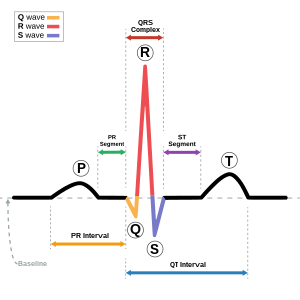Romano-Ward syndrome
| Romano–Ward syndrome | |
|---|---|
 |
|
| Schematic representation of normal ECG trace (sinus rhythm), with waves, segments, and intervals labeled. | |
| Classification and external resources | |
| ICD-10 | I45.8 |
| ICD-9-CM | 794.31 |
| OMIM | 192500 |
| DiseasesDB | 11661 |
| MeSH | D029597 |
| Orphanet | 101016 |
Romano–Ward syndrome is the major variant of long QT syndrome. It is a condition that causes a disruption of the heart's normal rhythm. This disorder is a form of long QT syndrome, which is a heart condition that causes the cardiac muscle to take longer than usual to recharge between beats; if untreated, the irregular heartbeats can lead to fainting, seizures, or sudden death
Romano–Ward syndrome presents the following in an affected individual:
Romano–Ward syndrome is inherited in an autosomal dominant pattern. It is the most common form of inherited long QT syndrome, affecting an estimated 1 in 7,000 people worldwide. It should be mentioned that long QT syndrome has 6 different variations, therefore Romano–Ward syndrome is one of many
The mechanism of Romano–Ward syndrome sees that mutations in the ANK2, KCNE1, KCNE2, KCNH2, KCNQ1, and SCN5A genes can cause Romano–Ward syndrome. The proteins made by most of these genes form channels transport positively-charged ions, such as K+ and Na+. In cardiac muscle, these ion channels play critical roles in maintaining the heart's normal rhythm. Mutations in any of these genes, for example ANK2, KCNE1, KCNE2, alter the structure or function of channels, which changes the flow of ions between cells, a disruption in ion transport alters the way the heart beats, leading to abnormal heart rhythm characteristic of the syndrome.
The protein made by the ANK2 gene ensures that other proteins, particularly ion channels, are inserted into the cell membrane appropriately. A mutation in the ANK2 gene likely alters the flow of ions between cells in the heart, which disrupts the heart's normal rhythm and results in the features of Romano–Ward syndrome.
...
Wikipedia
